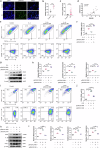piENOX2 regulates ALKBH5-mediated Itga4 m6A modification to accelerate the progression of rheumatoid arthritis
- PMID: 40702135
- PMCID: PMC12322066
- DOI: 10.1038/s12276-025-01503-3
piENOX2 regulates ALKBH5-mediated Itga4 m6A modification to accelerate the progression of rheumatoid arthritis
Abstract
Rheumatoid arthritis (RA) is a chronic autoimmune disorder characterized by synovitis and presenting as symmetrical arthritis that primarily affects the small joints of the limbs. PIWI-interacting RNAs, a class of small noncoding RNAs, have garnered significant attention due to their critical involvement in various pathological conditions, including reproductive diseases, cancers and other disorders. Here we observe elevated levels of macrophage-derived piENOX2 in the synovial tissues of both patients with RA and mice with collagen-induced arthritis (CIA). It was found that transfection with a piENOX2 mimic promoted M1 macrophage polarization, while a piENOX2 inhibitor facilitated M2 polarization. In vivo, a piENOX2 inhibitor significantly alleviated disease progression, reduced systemic inflammation and preserved the integrity of articular cartilage in CIA mice. Mechanistic analyses indicated that the piENOX2 effects were due to its targeting Alkbh5 mRNA for degradation. In a Alkbh5 conditional-knockout mouse model of CIA, the therapeutic effects of a piENOX2 inhibitor, including inflammation suppression and cartilage protection, were reduced compared with control mice. A comprehensive analyses using methylated RNA immunoprecipitation sequencing and methylated RNA immunoprecipitation and quantitative PCR revealed that piENOX2 regulated ALKBH5-mediated m6A modification of Itga4 mRNA, thereby influencing macrophage polarization through the PI3K-AKT signaling pathway. These findings provide important insights into the complex roles of PIWI-interacting RNAs in RA progression and indicate potential avenues for therapeutic intervention.
© 2025. The Author(s).
Conflict of interest statement
Competing interests: The authors declare no competing interests.
Figures







Similar articles
-
DS-Modified Paeoniflorin pH-Responsive Lipid-Polymer Hybrid Nanoparticles for Targeted Macrophage Polarization in a Rat Model of Rheumatoid Arthritis.Int J Nanomedicine. 2025 Jul 12;20:8967-8992. doi: 10.2147/IJN.S516434. eCollection 2025. Int J Nanomedicine. 2025. PMID: 40671689 Free PMC article.
-
Targeting myeloid differentiation protein 2 ameliorates rheumatoid arthritis by inhibiting inflammation and ferroptosis via MAPK and NF-κB signaling pathways.J Mol Med (Berl). 2025 Jul;103(7):821-836. doi: 10.1007/s00109-025-02555-8. Epub 2025 May 21. J Mol Med (Berl). 2025. PMID: 40397030
-
High CBD extract (CBD-X) modulates inflammation and immune cell activity in rheumatoid arthritis.Front Immunol. 2025 Jul 10;16:1599109. doi: 10.3389/fimmu.2025.1599109. eCollection 2025. Front Immunol. 2025. PMID: 40709173 Free PMC article.
-
Exploring the Role of Macrophages and Their Associated Structures in Rheumatoid Arthritis.J Innate Immun. 2025;17(1):95-111. doi: 10.1159/000543444. Epub 2025 Feb 12. J Innate Immun. 2025. PMID: 39938504 Free PMC article. Review.
-
The dual-edged sword: AlkB homolog 5-mediated autophagy regulation in cancers - molecular mechanisms and therapeutic implications: A review.Int J Biol Macromol. 2025 Sep;321(Pt 1):146227. doi: 10.1016/j.ijbiomac.2025.146227. Epub 2025 Jul 21. Int J Biol Macromol. 2025. PMID: 40701469 Review.
References
-
- Smith, M. H. & Berman, J. R. What is rheumatoid arthritis? Jama327, 1194 (2022). - PubMed
-
- Smolen, J. S. et al. EULAR recommendations for the management of rheumatoid arthritis with synthetic and biological disease-modifying antirheumatic drugs: 2022 update. Ann. Rheum. Dis.82, 3–18 (2022). - PubMed
-
- Aravin, A. et al. A novel class of small RNAs bind to MILI protein in mouse testes. Nature442, 203–207 (2006). - PubMed
-
- Girard, A., Sachidanandam, R., Hannon, G. J. & Carmell, M. A. A germline-specific class of small RNAs binds mammalian Piwi proteins. Nature442, 199–202 (2006). - PubMed
MeSH terms
Substances
Grants and funding
- 2024M752135/China Postdoctoral Science Foundation
- 2023M732376/China Postdoctoral Science Foundation
- 82302031/National Natural Science Foundation of China (National Science Foundation of China)
- ZR2024QH033/Natural Science Foundation of Shandong Province (Shandong Provincial Natural Science Foundation)
LinkOut - more resources
Full Text Sources
Medical

